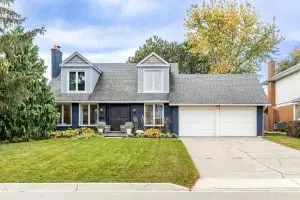New Jersey Is Failing in Affordability and Homebuilding: Can the Next Governor Change Course?
New Jersey’s housing market faces an all-too-familiar problem: too few homes and too many barriers to building them. The state earned a C- on the Realtor.com® State-by-State Housing Report Card, signaling a tough mix of high costs and limited construction.
The analysis, part of the Let America Build campaign, ranks states on how well they’re addressing housing supply and affordability.
But the Garden State is not alone with it comes to slow construction growth. Hoping to spur on action, President Donald Trump recently put pressure on large homebuilders to increase construction nationwide. In a post on his Truth Social platform in early October, he accused major builders of hoarding lots to prop up prices—likening them to OPEC, which restricts oil output to maintain high prices.
“They’re my friends ... but now, they can get Financing, and they have to start building Homes. They’re sitting on 2 Million empty lots, A RECORD,” Trump wrote. He urged Fannie Mae and Freddie Mac to intervene and “get Big Homebuilders going” to “restore the American Dream.”
But is there more New Jersey's own government can do to fix the problem, especially with a new incoming governor on the horizon?
A costly and constrained market
New Jersey’s total score of 45.4 places it among the lower-tier states in the nation. The median list price stood at $563,048 in 2024, while the median household income reached $96,278—a wide gap that leaves many buyers stretched thin.
The state’s construction numbers tell a similar story. New Jersey accounted for 2.5% of all new-housing permits nationwide but represents nearly 2.8% of the U.S. population, putting its permit-to-population ratio below 1. That imbalance signals that new construction isn’t keeping up with demand.
Meanwhile, the new-construction premium, or the price gap between new and existing homes, was 74.1%, one of the steepest in the country—evidence that most new builds are high-end and far from affordable for middle-income buyers.
Regional contrasts and national trends
The Realtor.com New Construction Insights 2025Q2 report found that new homes are becoming more competitive with existing ones. The median list price for a newly built home was $450,797, barely changed from a year earlier, while resale prices rose 2.4%. That led to a record-low new-construction premium of 7.8%, as builders nationwide worked to add inventory at more attainable prices.
In the Northeast, however, high land costs and regulatory complexity keep construction expensive and slow. While Southern and Midwestern states dominate the top of the national rankings for affordability and homebuilding, states such as New Jersey, Massachusetts, and Connecticut cluster near the bottom. Strict zoning rules, limited available land, and strong opposition to density continue to hold back production across the region.
“America is short more than 4.7 million homes, and every new home built helps close that gap while fueling local economies," says Shannon McGahn, executive vice president and chief advocacy officer at the National Association of Realtors®.
"NAR research shows that the U.S. has faced a persistent housing shortage for more than a decade, driving up prices and limiting options for buyers. Expanding housing supply creates jobs, supports small businesses, and affords families the opportunity to build generational wealth.”
Gov. Murphy’s affordable housing overhaul
During his tenure in office, Gov. Phil Murphy signed legislation to address one of the root causes of the shortage: uneven enforcement of the state’s long-standing affordable housing requirements. The law, known as Bill S50/A4, codifies the Mount Laurel Doctrine, the state’s constitutional rule requiring every town to provide its fair share of affordable housing.
The legislation streamlines the process for determining and fulfilling affordable housing obligations, reducing judicial intervention and legal delays that have historically slowed progress. It also provides clear formulas for calculating each municipality’s housing requirement, helping to lower litigation costs and create greater predictability for builders.
“Through this new framework, we are making housing more equitable and more efficient to deliver,” Murphy said when signing the law. “Every community in New Jersey has a role to play in ensuring working families have a place to call home.”
Since the state’s courts reinstated the Mount Laurel enforcement in 2015, New Jersey’s annual affordable housing production has nearly doubled, providing homes for more than 50,000 people. But the new law represents a long-term shift toward proactive, rather than reactive, housing policy—one that could help move the state’s construction pace closer to its population needs.
How the next administration will handle housing
On the Republican side, Jack Ciattarelli told Realtor.com his plan to breathe life into the housing sector, should he be elected.
“While some would say a C-minus is still a passing grade, I see it as a failure of New Jersey’s state government to create market conditions favorable to homebuyers, homebuilders, and the housing market as a whole,” he told Realtor.com. “Eight years of one-party control of government and 25 years of Democratic control of the Legislature have left us with stale, failing policies that can no longer continue if New Jersey is to thrive.”
Pointing to plans to cut and cap “property taxes to a percentage of assessed home value” as well as “banning property tax increases on home improvements,” he points to permitting as a “perennial issue” for new construction.
“I plan to modernize and streamline the state permitting system so that all necessary permits for residential housing are handled promptly and don’t create added expenses from regulatory delays. In addition, the economic boost provided by my broader plan—overseen by a streamlined, coordinated system under a Department of Commerce—will strengthen our economy and create a healthier housing market.”
On the other side of the aisle, Democrat candidate Mikie Sherrill has also vowed to work alongside the New Jersey Realtors and New Jersey Builders Association to make housing “affordable and accessible for all families and to create good-paying jobs in this sector.” (Realtor.com reached out to Congresswoman Sherrill for comment, but did not receive a reply.)
“We can’t make New Jersey more affordable without making housing more affordable,” Sherrill told 300 industry professionals at an event in October. “But right now, housing costs are up over 50% in just the past five years—making homeownership inaccessible for so many families.”
“That will change when I’m governor,” she added. “I’ll expand first-time homebuyer assistance to increase access to homeownership and generational wealth, end diversions from the Affordable Housing Trust Fund so these funds actually go toward expanding housing options families can afford, and work collaboratively with municipalities to redevelop underutilized properties like office parks and strip malls.”
Categories
Recent Posts










GET MORE INFORMATION

